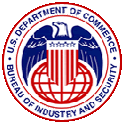 |
|
| Chemical Weapons Convention Bulletin | |
| Department of Commerce Bureau of Industry and Security | |
Introduction to Industry Implementation of the
Chemical Weapons Convention
CWC Chemicals
The CWC organizes certain toxic chemicals and precursors that have or could play a role in chemical weapons (CW) activity into three "schedules" and an additional basket category of chemicals, "unscheduled discrete organic chemicals" (UDOCs). The CWC verification regime allows the OPCW to monitor specified levels of commercial activities-production, processing, consumption, export and import-involving scheduled chemicals and UDOCs as required by the Convention. The Schedules of Chemicals are ordered to reflect an assessment of the risk posed to the object and purpose of the Convention-the elimination of CW. It is important to understand that "scheduled chemicals" means specific chemicals listed, as well as families of chemicals and any other chemicals meeting the criteria included in the CWCR and Convention.
Schedule 1 Chemicals
These chemicals pose the highest risk to the object and purpose of the Convention. They include nerve agents such as VX and blister agents such as Mustard. Schedule 1 also includes final stage precursors. Schedule 1 chemicals have little use for purposes other than those prohibited under the CWC.
Schedule 2 Chemicals
These chemicals pose a significant risk to the object and purpose of the Convention. They include toxic chemicals and precursors possessing properties that would enable them to be used in CW activities. Schedule 2 chemicals may be produced in large commercial quantities for purposes not prohibited under the CWC.
Schedule 3 Chemicals
These chemicals pose a risk to the object and purpose of the Convention. They include first generation CW and other toxic chemicals and precursors that might enable them to be used in CW activities. The U.S. chemical industry produces Schedule 3 chemicals in large commercial quantities for purposes not prohibited under the CWC.
Concentration Levels
The CWCR contain a "round to zero" rule for Schedule 1 chemicals, and low concentration exemptions for Schedule 2 and 3 chemicals. Unless deemed a risk to the object and purpose of the Convention by virtue of the total weight and ease of recovery of the chemical, scheduled chemicals in the following concentrations (by volume or weight, whichever is lower) are exempt from declaration and report requirements:
- Schedule 1 chemicals: ‹0.5% (unavoidable by-products or impurities)
- Schedule 2 chemicals: ‹30%
- Schedule 3 chemicals: ‹80%
Unscheduled Discrete Organic Chemicals
An unscheduled discrete organic chemical (UDOC) means any unscheduled chemical belonging to the class of chemical compounds consisting of all compounds of carbon except for its oxides, sulfides and metal carbonates [2], identifiable by chemical name, by structural formula, if known, and by Chemical Abstracts Service registry number, if assigned. In addition, a subcategory of UDOCs has also been created. Those UDOCs containing the elements phosphorous, sulfur or fluorine are referred to as "PSF-chemicals."
Certain UDOCs are exempt from declaration under the CWCR, including:
- ingredients or by-products in foods designed for consumption by humans and/or animals;
- products from the refining of crude oil, including sulfur-containing crude oil;
- polymer substances and oligomers consisting of two or more repeating units, and formed by the chemical reaction of monomeric or polymeric substances; and
- chemicals and chemical mixtures produced via a biological or biomediated process.
UDOC plant sites that produce hydrocarbons or explosives exclusively are also exempt from the CWCR's declaration requirements.
In addition, a coincidental UDOC byproduct of a manufacturing or production process that is not isolated or captured for use or sale during the process and that is routed to, or escapes, from the waste stream of a stack, incinerator, or wastewater treatment system or any other waste stream is exempted from declaration.
Classification Assistance
For assistance in determining whether your chemical is subject to declaration or report requirements, contact BIS's Information Technology Team. To ensure expeditious processing, please provide the following information for each chemical: the chemical name, the structural formula, and the CAS Registry Number, if assigned. BIS will respond within 10 working days of request.
1 The specific criteria included in the CWC are provided at Annex C.
2 For further explanation of these exempted compounds, see Annex D.
3. For BIS contact information, see Annex E.
Education, Assistance & Support
Publication CWC-004
[ PART 4 OF 13 ]